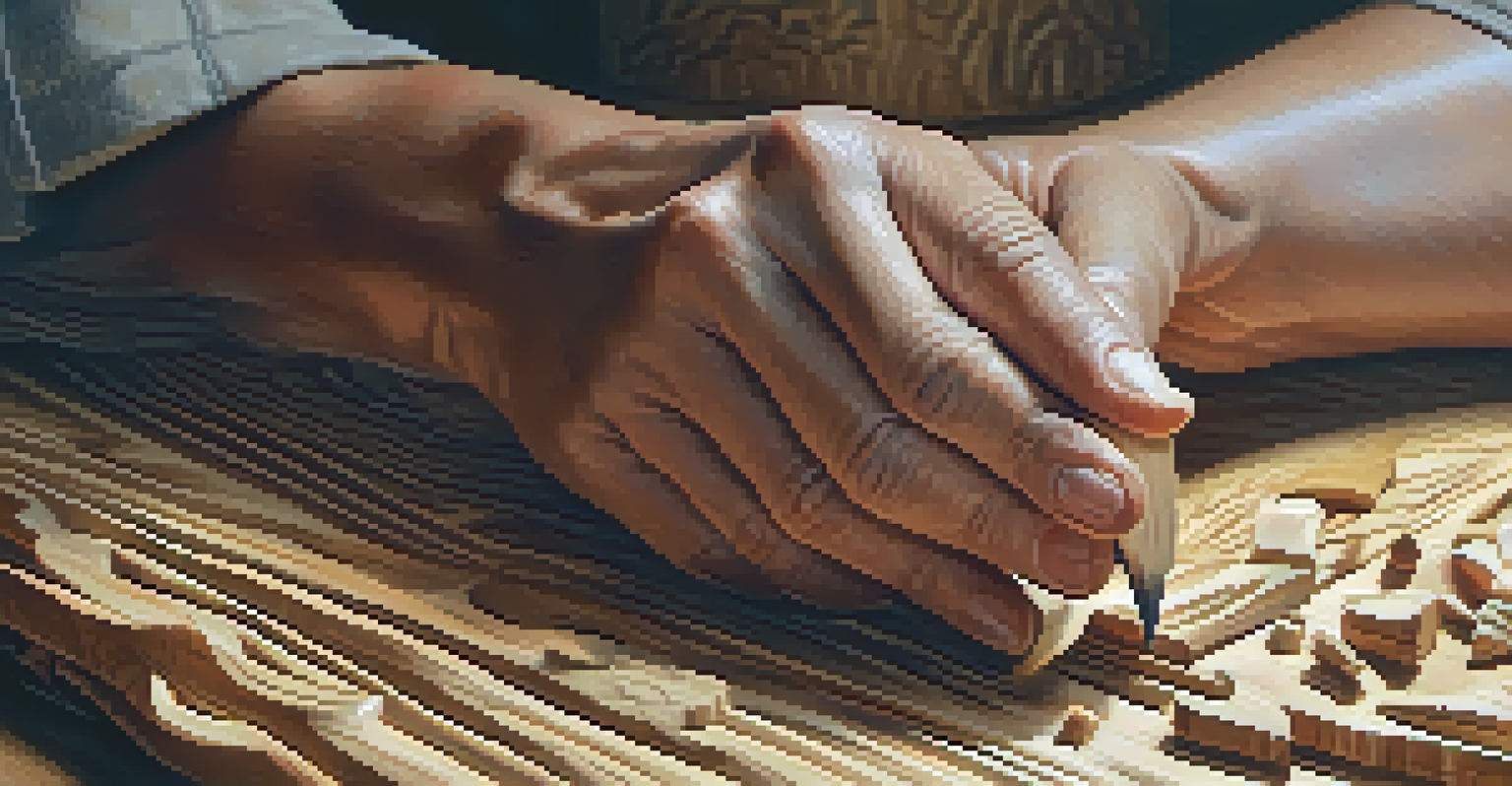The Spiritual Significance of Wood Carving in Cultures

Understanding the Roots of Wood Carving Spirituality
Wood carving has been a significant artistic expression across many cultures for centuries. Each piece carved from wood holds a story, often reflecting the beliefs and values of the society that created it. The natural origins of wood symbolize life, growth, and connection to the earth, which enhances the spiritual depth of this craft.
Art is not freedom from discipline, but disciplined freedom.
In many cultures, wood is seen as a living material, imbued with spirit and energy. This belief often leads to the practice of carving to honor deities, ancestors, or nature itself. For instance, in Indigenous cultures, carvings can represent totems or spiritual guides, embodying the essence of the beings they depict.
The act of carving itself can also be a meditative practice, allowing artisans to connect with their inner selves and the larger universe. As they work, they often find a sense of peace and purpose, making the process both a spiritual journey and a form of artistic expression.
Cultural Significance of Wood Carving in African Traditions
African wood carving is rich with meaning, often reflecting communal beliefs and traditions. Masks, sculptures, and everyday objects serve not only practical purposes but also spiritual ones, bridging the gap between the physical and the spiritual worlds. These carvings can represent ancestors, spirits, or even abstract concepts tied to community identity.

For many African cultures, the process of carving is a communal activity, involving the sharing of stories and collective wisdom. The carver is seen as a storyteller, using wood as a canvas to depict narratives that resonate with the community’s history and values. This connection fosters a deep sense of belonging and continuity.
Wood Carving as Spiritual Expression
Wood carving serves as a profound artistic expression that reflects cultural beliefs and connects individuals to their spirituality.
Moreover, African wood carvings are often used in rituals and ceremonies, enhancing their spiritual significance. Whether it’s a mask worn during a dance or a sculpture used in worship, these pieces become conduits for spiritual energy, allowing practitioners to connect with the divine or the ancestral spirits.
The Role of Wood Carving in Native American Spirituality
In Native American cultures, wood carving is a vital expression of spirituality and identity. Carvings often depict animals, nature, or figures from mythology, symbolizing the interconnectedness of all living things. This reflects a worldview where nature is sacred and every element has a spirit.
Creativity takes courage.
Many tribes believe that carving wood brings forth the spirit of the tree, giving life to the object created. For instance, the Haida people of the Pacific Northwest are renowned for their totem poles, which tell stories of lineage, spirituality, and cultural heritage. Each carving is not just a work of art, but a representation of the tribe’s beliefs and history.
Additionally, the act of carving itself can be seen as a spiritual practice, where artisans enter a state of focus and reverence. This mindfulness transforms the simple act of carving into a profound connection with their culture and spirituality, allowing for personal and communal expression.
Wood Carving in Asian Spiritual Practices
Across Asia, wood carving plays a crucial role in various spiritual practices, from Buddhism to Shinto. In many Asian cultures, intricate carvings adorn temples, shrines, and sacred spaces, serving as reminders of the divine. These carvings often depict deities, mythical creatures, or symbols that convey deep philosophical meanings.
For example, in Buddhist culture, wooden sculptures of Buddha are not just decorative; they are considered embodiments of enlightenment. The craftsmanship involved in creating these pieces is seen as an offering, turning the act of carving into a spiritual discipline. Each detail is meticulously crafted to reflect the qualities of compassion and wisdom.
Cultural Significance in Communities
In various cultures, wood carving is not only an art form but also a communal activity that preserves stories and fosters a sense of belonging.
Moreover, the symbolism in Asian wood carving often extends to everyday objects, infusing them with spiritual significance. Items such as bowls or furniture may carry motifs that promote harmony and balance, reminding users of their connection to the universe and the importance of mindfulness in daily life.
The Spiritual Journey of Wood Carving in European Folklore
In Europe, wood carving has a storied history intertwined with folklore and mythology. Many cultures view wood as a mystical material, often associated with the forest and its spirits. Carvings of mythical creatures or folkloric figures serve to protect communities, acting as guardians against negative energies.
For instance, the intricate carvings of the Celtic tradition often depict nature and animal forms, reflecting a deep respect for the environment and its spiritual essence. These carvings are not merely decorative; they carry stories and symbols that connect people to their ancestral roots and the natural world around them.
Additionally, wood carving in Europe has been a way to preserve cultural narratives and beliefs. Churches and cathedrals adorned with wooden sculptures often tell biblical stories, bridging the sacred and the everyday. This practice infuses spiritual significance into the architecture, inviting reflection and reverence from all who enter.
The Therapeutic and Spiritual Aspects of Wood Carving
Beyond its cultural significance, wood carving offers therapeutic benefits that enhance its spiritual value. Engaging in this craft can provide a sense of calm and focus, allowing individuals to escape the hustle and bustle of everyday life. The rhythmic action of carving can be meditative, promoting mindfulness and presence.
Many people find that working with wood helps them connect with nature, grounding them in a way that fosters spiritual growth. This connection can lead to greater self-awareness and emotional healing, as artisans pour their thoughts and feelings into each piece. The wood becomes a canvas for self-expression, transforming emotions into tangible forms.
Therapeutic Benefits of Carving
Engaging in wood carving provides therapeutic benefits, promoting mindfulness and personal growth through the creative process.
Furthermore, the finished carvings often carry a piece of the carver’s spirit, making each creation unique and meaningful. Whether shared with others or kept as a personal treasure, these carvings serve as reminders of the journey taken, both artistically and spiritually.
Connecting with the Spiritual through Wood Carving Workshops
Participating in wood carving workshops can be a profound way to connect with both the craft and its spiritual significance. These workshops often emphasize not only the technical skills of carving but also the cultural stories and meanings behind the art. This holistic approach deepens the participants' understanding and appreciation of wood carving.
In a workshop setting, individuals can share their experiences and insights, fostering a sense of community and connection. This collective space allows for the exchange of ideas and techniques, enhancing the spiritual experience of carving as a shared journey. Participants often leave with not only a carved piece but also a sense of belonging.

Moreover, engaging in the tactile process of carving can be a transformative experience. As participants immerse themselves in the craft, they may discover new aspects of themselves and their spirituality. This journey into wood carving can spark a lifelong passion, creating a bridge between art, culture, and personal growth.